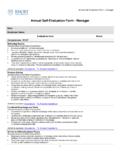Transcription of Expert’s Guide to Successful MRP Projects - Toolbox.com
1 expert 's Guide to Successful MRP Projects September 2012. Ziff Davis Research All Rights Reserved 2012.. White Paper Executive Summary For most manufacturers, the planning department performs business critical functions. It is responsible for balancing organizational supply with demand, and directing production, distribution, and purchasing activities accordingly. A planning department strives to balance oftentimes competing organizational forces, including customer service, inventory requirements, and operating efficiency. To succeed in their tasks, planners and schedulers rely on materials resource planning (MRP) software to make recommendations and send signals.
2 MRP software typically covers purchase planning, master production scheduling, capacity requirements planning, and distribution planning, among other things. To make meaningful suggestions, MRP requires a steady diet of accurate, relevant, and timely data. If any of these data requirements are missing, MRP is likely to issue recommendations that are harmful not helpful to a company. And, the potential harm can be significant, including: bloated inventories, missed order promise dates, and production schedules that are unresponsive to actual demand priorities. In this expert 's Guide to Successful MRP Projects , we break down two critical MRP project success factors: 1) Tips to select the right MRP software, and 2) Best-practices to extract meaningful value from MRP solutions More specifically, this report covers the following: An Historical Definition of MRP.
3 MRP Today Manufacturing Resource Planning (MRP II). A The Planning and Scheduling Department A Control Tower Function A Prerequisite to MRP Success Timely and Accurate Data Key Requirements when Evaluating MRP Functionality in a Selection project Order Quantity Parameters Lead Time Parameters Purchase and Production Order Dates Production Routings Production Bill-of-Materials expert 's Guide to Successful MRP Projects Page 2 of 16. Ziff Davis | White Paper | expert 's Guide to Successful MRP Projects expert 's Guide to Successful MRP. Projects Table of Contents Overview Leveraging MRP to Balance Supply with Demand.. 4. Historical Definition of MRP.
4 5. MRP Today Manufacturing Resource Planning (MRP II) .. 5. The Planning and Scheduling Department A Control Tower Function .. 6. A Prerequisite to MRP Success - Timely and Accurate Data .. 7. Key Requirements When Evaluating MRP Functionality in a Selection project .. 7. Order Quantity Parameters.. 8. Lead Time Parameters .. 9. The Importance of Purchase and Production Order Dates.. 10. Production Routings.. 12. Production Bills-of-Materials.. 12. Conclusion.. 15. expert 's Guide to Successful MRP Projects Page 3 of 16. Ziff Davis | White Paper | expert 's Guide to Successful MRP Projects Overview Leveraging MRP to Balance Supply with Demand Without question, the success of any manufacturing business depends on its ability to maintain an appropriate balance between supply and demand.
5 And, manufacturers rely on their planning and scheduling departments to achieve this balance. Planners and schedulers, in turn, lean on MRP software systems to help them execute material requirements plans, master production schedules, and capacity requirements plans. MRP software performs complex calculations to make suggestions that are intended to put the right people and product in the right places to satisfy demand requirements. However, MRP will be incapable of making meaningful suggestions if the underlying data is either not timely, not accurate, or not co In this expert 's Guide to MRP, we break down best-practices that companies can leverage to achieve the following purposes: Selecting MRP solutions that fit their requirements Implement business processes to optimize the effectiveness of MRP solutions In the sections that follow, we break down a brief history of MRP's evolution, followed by a discussion of the key requirements to Successful MRP project execution.
6 Specifically, this report covers the following: An Historical Definition of MRP. MRP Today Manufacturing Resource Planning (MRP II). A The Planning and Scheduling Department A Control Tower Function A Prerequisite to MRP Success Timely and Accurate Data Key Requirements when Evaluating MRP Functionality in a Selection project Order Quantity Parameters Lead Time Parameters Purchase and Production Order Dates Production Routings Production Bill-of-Materials expert 's Guide to Successful MRP Projects Page 4 of 16. Ziff Davis | White Paper | expert 's Guide to Successful MRP Projects Historical Definition of MRP. Historically, there was only one definition of MRP, and that was material requirements planning.
7 Under this historical regime, manufacturers would leverage computer information systems to plan material movements through an organization's supply chain and production processes. These systems would generate requirements in a time-phased manner by netting out gross requirements against on-hand and in-process inventory . MRP would also make recommendations relating to master production scheduling and capacity requirements planning. APICS - the American Production and Inventory Control Society defines material requirements planning as follows: A system built around material requirements planning that includes the additional planning processes of production planning (sales and operations planning), master production scheduling, and capacity requirements planning.
8 One of the critical success factors of material requirements planning was the development of a closed-loop system that fed execution-related data back into the planning process. This was a very important development because the real world seldom proceeded according to plan. For example, customers change orders, suppliers miss delivery windows, production workers get sick, and machines unexpectedly break down. To make plans meaningful, companies needed their systems to account for these types of changes. APICS describes the closed-loop planning system as follows: Once this planning phase is complete and the plans have been accepted as realistic and attainable, the execution processes come into play.
9 These processes include the manufacturing control processes of input-output (capacity) measurement, detailed scheduling and dispatching, as well as anticipated delay reports from both the plant and suppliers, supplier scheduling, and so on. The term closed loop implies not only that each of these processes is included in the overall system, but also that feedback is provided by the execution processes so that the planning can be kept valid at all times. MRP Today Manufacturing Resource Planning (MRP II). The historical version of MRP - material requirements planning gave companies an opportunity to rationalize operations by integrating processes relating to the planning and scheduling of materials, resources, production, and capacity.
10 In the mid-1980s, manufacturers realized that they could extend integration to other corners of expert 's Guide to Successful MRP Projects Page 5 of 16. Ziff Davis | White Paper | expert 's Guide to Successful MRP Projects their businesses. Oliver Wight, author of Manufacturing Resource Planning: MRP II, explains the rationale of enterprise integration, as follows: Once the operating system in a manufacturing company could be made to work and the closed loop MRP [materials requirements planning] system did work in a good many companies making MRP a whole company system was the next logical step. MRP II is a system that includes manufacturing, finance, marketing, engineering, purchasing, distribution and certainly changes a lot of things for data processing people.





